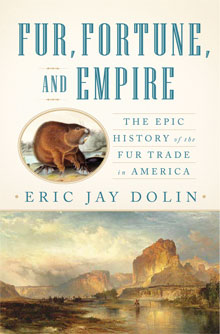Eric Jay Dolin, PhD ‘95, admits that before he began work on Fur, Fortune, and Empire, he knew little about the fur trade. “What I did know was essentially limited to the mountain-men era,” he says. But Dolin became curious about the subject after reading James Truslow Adams’s The Founding of New England a few years ago. In that book, which won the 1922 Pulitzer Prize for history, Adams asserted that the Bible and the beaver were the two mainstays of the Plymouth Colony in its early years. “Given that the Pilgrims were Puritan separatists who went to America to escape religious persecution, I understood Adams’s reference to the Bible,” Dolin says. “But I had no idea why he had thrown beavers into the mix.”

By Eric Jay Dolin, PhD ’95
W. W. Norton, 2010, $29.95
Intrigued, Dolin hit the library. He learned that for more than a decade after their arrival in America, the Pilgrims made most of their money through the sale of beaver pelts, which they shipped to London. “Within a couple of days, I experienced that exhilarating feeling that comes when you find a great book topic,” he recalls. “What really excited me was that I realized I could use the history of the fur trade as a narrative backbone to tell a broader and equally fascinating story about how America evolved from a loose collection of colonies into a transcontinental nation.”
Recounting the history of the fur trade gave Dolin an opportunity to research characters such as Thomas Morton, who set up a community in what’s now Quincy, MA, where he traded guns with the Indians and threw wild parties; the multimillionaire John Jacob Astor, whose attempt to expand his fur-trading empire to the Pacific coast ultimately failed in a dramatic fashion; and Marie Dorion, an Iowa Indian and the only female to take part in the cross-country expedition Astor sponsored, who with her two young sons survived for months in the winter wilderness after her husband and the rest of their trapping party were attacked by Indians.
A former fisheries policy analyst at the National Marine Fisheries Service and a onetime environmental consultant, Dolin earned his doctorate at MIT in environmental policy and planning. But he has always enjoyed storytelling, and about eight years ago he decided to give full-time writing a go. In his new career, he continues to be drawn to topics that relate to the natural world: his previous books include Political Waters, about the pollution and cleanup of Boston Harbor, and Leviathan: The History of Whaling in America, which won several awards.
Though cruelty to animals and the ethics of wearing fur weren’t hotly contested issues during the era covered in Dolin’s book, he points out some key lessons that modern-day readers can learn from our country’s fur-trading past. In addition to demonstrating the importance of natural resources to the economy, he says, “the fur trade shows how humankind, driven by the desire to make money and with little regard for the natural world, can wreak havoc with nature and push species to the verge of extinction.”
Keep Reading
Most Popular
Large language models can do jaw-dropping things. But nobody knows exactly why.
And that's a problem. Figuring it out is one of the biggest scientific puzzles of our time and a crucial step towards controlling more powerful future models.
How scientists traced a mysterious covid case back to six toilets
When wastewater surveillance turns into a hunt for a single infected individual, the ethics get tricky.
The problem with plug-in hybrids? Their drivers.
Plug-in hybrids are often sold as a transition to EVs, but new data from Europe shows we’re still underestimating the emissions they produce.
Google DeepMind’s new generative model makes Super Mario–like games from scratch
Genie learns how to control games by watching hours and hours of video. It could help train next-gen robots too.
Stay connected
Get the latest updates from
MIT Technology Review
Discover special offers, top stories, upcoming events, and more.